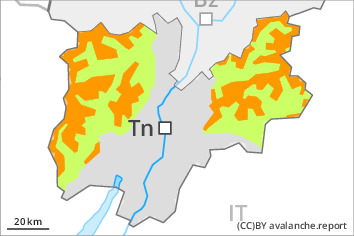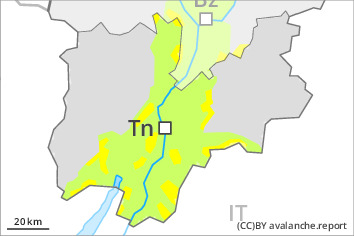
Danger level
 | treeline |
|  |
|  | ||||
|  |
|  |

The fresh snow as well as the wind slabs represent the main danger. Weakly bonded old snow above approximately 2200 m.
As a consequence of a sometimes strong northeasterly wind, avalanche prone wind slabs will form from early morning over a wide area. The fresh wind slabs can be released easily, even by a single winter sport participant,. The avalanche prone locations are to be found in all aspects above the tree line, in particular in gullies and bowls, and behind abrupt changes in the terrain, as well as adjacent to ridgelines. At elevated altitudes and in the regions exposed to the foehn wind the avalanche prone locations are more prevalent and the danger is greater. Individual natural avalanches are not ruled out.
To some extent avalanches can also be released in the old snowpack. Such avalanche prone locations are to be found on steep, little used shady slopes above approximately 2200 m and on steep sunny slopes above approximately 2500 m. Whumpfing sounds and the formation of shooting cracks when stepping on the snowpack indicate the danger.
Backcountry touring and other off-piste activities call for experience in the assessment of avalanche danger and careful route selection.
Snowpack
dp.6: cold, loose snow and wind
dp.1: deep persistent weak layer
Especially in the east 5 to 10 cm of snow fell yesterday. As a consequence of a gathering strong wind from northeasterly directions, extensive wind slabs will form from early morning. These will be deposited on soft layers. The snowpack will become increasingly prone to triggering.
Faceted weak layers exist in the old snowpack, especially on shady slopes above approximately 2200 m, as well as on sunny slopes above approximately 2500 m.
Tendency
Some snow has fallen over a wide area. As a consequence of low temperatures and the occasionally storm force northeasterly wind, the snowpack can not consolidate on Thursday. As a consequence of the strong wind the wind slabs will increase in size additionally. Considerable avalanche danger will be encountered over a wide area.



